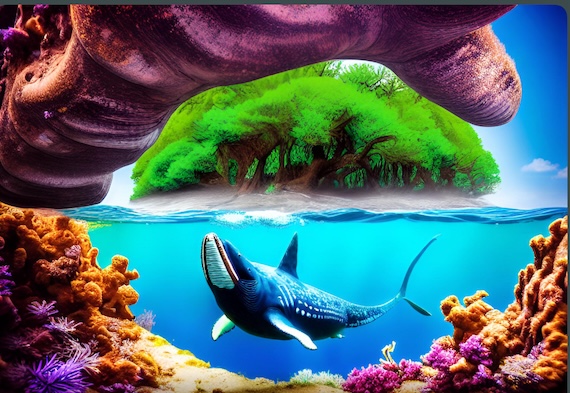Greenfield, Mass. (Special to Informed Comment; Feature) – From the largest to the smallest and the oldest to the youngest creatures on Earth–Antarctic blue whales and coastal redwood trees, minute bacteria and human beings–we are all enmeshed in layers of relationships. We need each other, though some more than others. Plants evolved hundreds of millions of years before the first humans and transformed the Earth–through their creativity in surviving predators–into a livable environment for all animals, including humans. We needed plants for our evolution and need them now for our survival from climate disaster. They, however, did not need us for their existence and would survive without us.
Putting humans at the top of the evolution chain as the crown of intelligent life, a western worldview, is–as some keenly grasp–mistaken. The baleful consequences of this simplistic hierarchy are everywhere: out-of-control climate, accelerating rates of animal and plant extinction, dead zones in the oceans and mass mortality of coral reefs; the vast pollution of land, air and water and the mounting likelihood of human extinction with nuclear war. All caused by humans, humans with financial and political power much more egregiously than others.
Certain scientists who study plants–from the simplest to the exotic–are stirring controversy with their “Are plants intelligent?” Consider that we humans owe our lives to plants for their food, medicines, and critical balance of 21% oxygen in air we breathe. If our human intelligence has discerned over thousands of years which plants are edible and nutritious and healing, wouldn’t the evolutional ingenuity of plants which feed and sustain us and all life also constitute intelligence?

“Plant Intelligence,” Digital, Dream / Dreamland v. 3, 2024
Studies have found that elephants recognize themselves in a mirror; crows create tools; dolphins demonstrate empathy and playfulness; and cats exhibit similar styles of attachment as human toddlers. The given explanation is that they have brains with neurological capacity for consciousness and intelligence.
But plants do not have a central brain. Could their mode of learning to evade insect predators and maximize their growth come from a diverse form of intelligence, possibly be distributed across their roots, stems and leaves? Could the whole plant, then, function as a brain? Recent studies of plants have stirred the possibility that they are conscious and intelligent. Take communication, something we humans claim as our domain through language and more recently acknowledge that animals also possess.
Botanists have found that not only do alder and willow trees alter their leaf chemistry to defend themselves against an invasion of tent caterpillars, but that leaves of faraway trees also change their chemical composition similarly. Warned, as they are, by airborne plant chemicals released from the original trees under attack. Goldenrods signal an attack by a predator through strong chemical communication sent to all other goldenrod neighbors, just as humans warn their neighbors about a nearby fire or flood or crime.
Without any recognizable ears, plants sense sounds. The vibration of a predator insect chewing on its leaves causes a plant to make its own defensive pesticide. Beach evening primrose responds to the sound of honeybees in flight by increasing the sweetness of its nectar to attract them for pollination. Tree roots grow toward the sound of running water, including in pipes, where the roots often burst through causing great difficulties for municipalities. How do the various plants hear these stimulating sounds?
Plants have memory, some anticipating from past experience when a pollinator will show up for the plants’ pollen. Plants express social intelligence: members of the pea family form relationships with bacteria living in their roots to have the bacteria supply beneficial nitrogen for the plants’ growth. Several kinds of plants provide a home and food for compatible ants who then attack the plants’ ant pests. Perhaps you have you noticed that late summer asters and goldenrod tend to grow as companions. Why? Together–their combined beauty–attracts more pollinators.
In finishing, I express my immense respect for the indigenous worldview where wind, rocks, air and rain are our kin, together with plants and nonhuman animals. We, humans, the most recent beings, depend on all of these elder kin; and this awareness, this worldview of connectivity among all beings, is our path back to Earth well-being.
Featured Image, “Web of Intelligent Life,” Digital, Dream / Realistic v. 2, 2024



 © 2025 All Rights Reserved
© 2025 All Rights Reserved